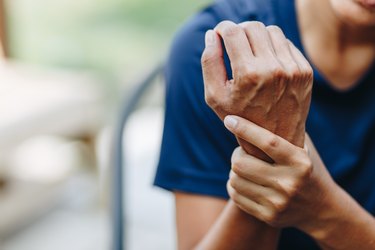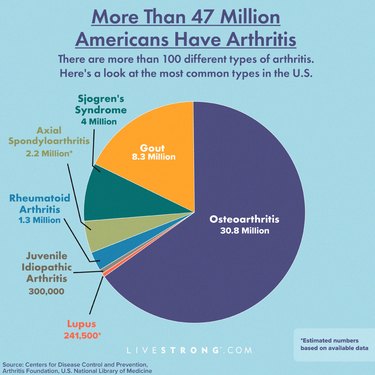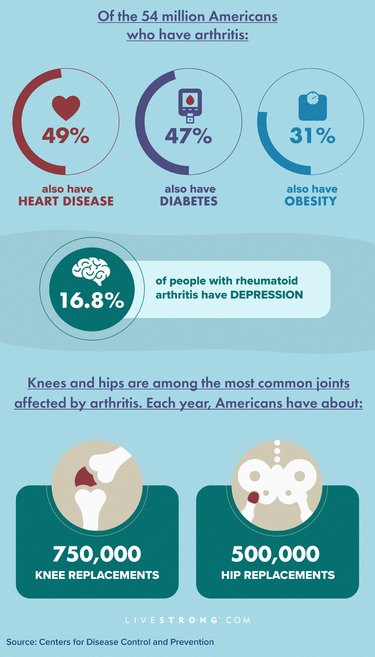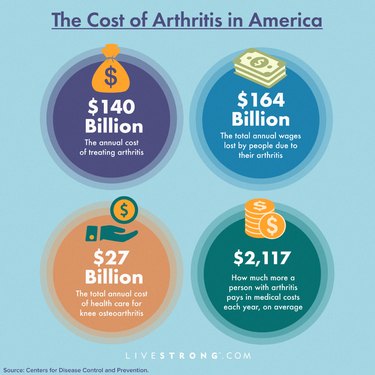
When many people think of arthritis, they think of a general "wear and tear" condition that affects the joints. But in fact, there are more than 100 different forms of arthritis, according to the Centers for Disease Control and Prevention (CDC).
Arthritis is a common condition, with the most common types being rheumatoid arthritis, lupus, psoriatic arthritis, gout, juvenile idiopathic arthritis and osteoarthritis, which is the most widespread.
Video of the Day
Video of the Day
Read on to learn more facts about arthritis, and statistics for each type.
Osteoarthritis vs. Inflammatory Arthritis
The different types of arthritis fall into two major groups, according to the Mayo Clinic:
- Osteoarthritis occurs when the cartilage in joints wears down due to injury, overuse or age.
- Inflammatory arthritis refers to a group of autoimmune diseases in which the body's own immune system attacks and damages its joints and tissues. Rheumatoid arthritis is the most common form.
Osteoarthritis
- Osteoarthritis (OA) affects about 500 million people worldwide (about 7 percent of the global population), and 32.5 million people in the United States, according to the Arthritis Foundation.
- Worldwide, an estimated 15% of people over the age of 60 have osteoarthritis, according to the Arthritis Foundation.
- Osteoarthritis is the fifth most common disability in the world.
- Knee osteoarthritis accounts for four-fifths of the burden of OA worldwide, per a November 2020 review in The Lancet Discovery Science.
- Every year, doctors perform 1 million OA-related knee and hip replacement surgeries in the U.S., per the Osteoarthritis Action Alliance.
Rheumatoid Arthritis
- Rheumatoid arthritis (RA) statistics show the condition affects more than 18 million people worldwide, according to the Institute for Health Metrics and Evaluation's 2019 Global Burden of Disease study.
- RA affects more than 1.3 million people in the U.S., per the American College of Rheumatology.
- About 75% of people with RA are assigned female at birth (AFAB).
- In 2011, RA was diagnosed in 6.4 million ambulatory (non-hospital) visits worldwide, per the Arthritis Foundation.
- About 2.1 million U.S. adults had RA in 1990. This number has likely dropped because there are fewer cases, and because the classification criteria has become more restrictive, per the National Arthritis Workgroup.
Psoriatic Arthritis
- Roughly 30% of people who have psoriasis — an immune condition marked by raised, scaly patches on the skin — develop psoriatic arthritis, per the National Psoriasis Foundation.
- About 2.4 million people in the U.S. have psoriatic arthritis. It typically occurs between the ages of 30 and 50.
- Psoriatic arthritis affects an estimated 24 in 10,000 people, according to the National Library of Medicine (NLM).
- While the prevalence of psoriasis is more common in white people (3.6%) versus Black people (1.5%), researchers believe it is under-diagnosed in minority communities, per the National Psoriasis Foundation.
Gout
- About 8.3 million people in the U.S. have gout, per the Hospitals for Special Surgery (HSS).
- 90% of gout attacks occur in a single joint, like the last joint of the large toe, per the HSS.
- 90% of people with gout have comorbidities like kidney dysfunction, coronary heart disease, obesity and diabetes.
Lupus
- At least 5 million people worldwide have some form of lupus, per the Lupus Foundation of America. About 95 percent of them will experience arthritis or joint pain during the course of their disease, according to the Johns Hopkins Lupus Center.
- More than half of people with lupus have polyarthritis (arthritis affecting five or more joints) when they're first diagnosed.
- 90% of people living with lupus are people AFAB between the ages of 15 and 44.
- 1 in 3 lupus patients deal with multiple autoimmune diseases, per the Lupus Foundation of America.
- Lupus affects an estimated 161,000 people in the U.S. (although that number may be as high as 322,000), according to the CDC.
Axial Spondyloarthritis
- Axial spondyloarthritis — a type of inflammatory arthritis that typically causes pain and swelling in the spine — affects an estimated 2.7 million people, according to the Arthritis Foundation.
- The U.S. population prevalence of axial spondyloarthritis (0.9% to 1.4%) is higher than the diagnostic prevalence (0.2% to 0.7%), per a December 2018 study in Clinical Rheumatology.
- Only 37% of people with axial spondyloarthritis are diagnosed by rheumatologists; 63% are diagnosed by primary care doctors, per the Clinical Rheumatology study.
- Only 5% of individuals with chronic back pain in the U.S. actually have axial spondyloarthritis.
Sjögren’s Syndrome
- Sjögren's syndrome is a chronic autoimmune disease that affects more than 4 million people in the U.S., per the Arthritis Foundation. It can lead to joint pain and inflammation on its own, or it may occur along with an inflammatory form of arthritis, such as rheumatoid arthritis or lupus.
- About 30 percent of people with RA also have Sjögren's syndrome, according to March 2020 research in Clinical Rheumatology.
- About half of people with Sjögren's have been diagnosed with another autoimmune disorder, according to Johns Hopkins Medicine.
- About 9 in 10 people with the condition are those AFAB.
- 7 in 10 people with Sjögren's syndrome say they struggle to cope with the disease on a weekly or more frequent basis, per the Arthritis Foundation.
Juvenile Idiopathic Arthritis
- Just under 300,000 children have juvenile idiopathic arthritis, according to the NLM. That's about 1 to 2 in 1,000 children, per the Arthritis Foundation.
- Juvenile idiopathic arthritis has been identified all over the world in nearly all races and ethnicities.
- About 25% of children with JIA have inflammation in five or more joints, called polyarticular JIA.
Arthritis Prevalence and Future Impact in the U.S.

Nearly a quarter of the United States population has been diagnosed with arthritis — a total of 54 million people, according to the CDC. It's little wonder, then, that arthritis is the leading cause of disability among adults in the country, according to the Arthritis Foundation.
In fact, by 2030, the number of people with arthritis (adults 18 years and older) is expected to rise to 67 million, per the National Arthritis Workgroup. And by 2040, an estimated 30.6 million adults will report arthritis-attributable activity limitations, per the CDC.
Prevalence of Arthritis by State and Territory in the U.S.
At least 1 in 6 adults in every state has arthritis. In states with the highest prevalence rates, about 1 in 4 people have arthritis, according to the CDC.
Here's the full breakdown:
- Alabama: 29.6%
- Alaska: 22.9%
- Arizona: 21.5%
- Arkansas: 28.8%
- California: 18.7%
- Colorado: 22.3%
- Connecticut: 21.3%
- Delaware: 23.6%
- District of Columbia: 19.1%
- Florida: 21.5%
- Georgia: 23.3%
- Guam: 18.7%
- Hawaii: 18%
- Idaho: 22.8%
- Illinois: 19.4%
- Indiana: 25.8%
- Iowa: 23.3%
- Kansas: 24.5%
- Kentucky: 28.3%
- Louisiana: 27.3%
- Maine: 26.5%
- Maryland: 22.3%
- Massachusetts: 22.1%
- Michigan: 26.6%
- Minnesota: 20.4%
- Mississippi: 27.8%
- Missouri: 26.2%
- Montana: 24.4%
- Nebraska: 22.1%
- Nevada: 21.5%
- New Hampshire: 23.9%
- New Jersey: 20%
- New Mexico: 22.4%
- New York: 20.9%
- North Carolina: 24.5%
- North Dakota: 24.1%
- Ohio: 27.1%
- Oklahoma: 25.4%
- Oregon: 22.3%
- Pennsylvania: 24.7%
- Puerto Rico: 18.4%
- Rhode Island: 25.4%
- South Carolina: 26.4%
- South Dakota: 21.3%
- Tennessee: 27.5%
- Texas: 20.6%
- Utah: 21.7%
- Vermont: 24.4%
- Virginia: 24.7%
- Washington: 22.8%
- West Virginia: 32.2%
- Wisconsin: 24.5%
- Wyoming: 21.7%
Arthritis Prevalence by Age, Sex and Race
People assigned female at birth (AFAB) are more likely than those assigned male at birth (AMAB) to have arthritis, including rheumatoid arthritis, lupus, Sjögren's syndrome and, after the age of 60, osteoarthritis, according to the Arthritis Foundation.
It's also estimated that in the U.S., 2.9 million Hispanic adults and 4.6 million non-Hispanic Black adults report doctor-diagnosed arthritis, per the National Arthritis Workgroup.
Here's a more detailed look at who is most affected by arthritis:
- People AFAB and over the age of 60 are almost twice as likely to have osteoarthritis than people AMAB in the same age group.
- About 18% of those AFAB over the age of 60 have osteoarthritis compared to 9.6% of people AMAB over the age of 60.
- People AFAB are two to three times more likely to have rheumatoid arthritis than those AMAB. There's no specific age of onset for rheumatoid arthritis, but it typically begins in middle age, according to the Mayo Clinic.
- About 15% to 20% of people with lupus develop the condition before the age of 18.
- About 80% of all lupus diagnoses are made in people AFAB between the ages of 15 and 44.
- Minorities in the U.S. — including Asians, African Americans, African Caribbeans and Hispanic Americans — are more likely to have lupus than white Americans.
- The prevalence of lupus in Native American and Alaska native populations are as high or higher than the rates reported for the Black population, about 178 per 100,000 people, according to the Arthritis Foundation.
- About 9 in 10 people with Sjögren's syndrome are people AFAB.
- More young people AFAB than AMAB may have juvenile idiopathic arthritis.
Arthritis Complications and Comorbidities Data

While there's no specific mortality rate for arthritis because the condition itself isn't deadly, it is more common in people who have certain other health problems, according to the CDC.
What's more, arthritis prevalence is highest among adults reporting no leisure time physical activity (about 23.6 percent), per the CDC. This inactivity can increase the risk of conditions like heart disease and diabetes.
Here's a look at the conditions and complications that are linked to arthritis:
- 29% of people with arthritis have obesity.
- More than 16%, however, are considered to be at a "normal" weight, per the CDC.
- 47% of people with arthritis have diabetes. (Check out more diabetes statistics here.)
- 49% of people with arthritis have heart disease.
- In 2013, arthritis accounted for more than 105.7 million healthcare visits (accounting for more than 10% of all visits), according to the Arthritis Foundation.
- Hospitalizations due to arthritis accounted for 6 percent of all visits in 2013.
- In 2010, 2011 and 2012, between half a million to three-quarters of a million total knee replacements were performed on Americans annually. And, between 465,000 to 512,000 hip replacements were likely performed in the U.S. in 2010 and 2011. (The knees and hips are among the most common joints affected by arthritis.)
- Arthritis is the most common chronic condition among people in the U.S. who take opioids.
- A 2015 Arthritis Care & Research Study found that people in pain with one lower joint — their knee or hip — were 53 percent more likely to fall. Those with two affected joints had a 74 percent higher chance and people with three to four painful joints were 85 percent more likely to fall, per the Arthritis Foundation.
- About 23.7 million people ages 18 and older with arthritis — about 43.5% of those with the condition — say it limits their ability to do their usual activities, according to the CDC.
- About 16.8% of people with rheumatoid arthritis have depression, according to the Arthritis Foundation.
- Only 23% of children with juvenile idiopathic arthritis get enough physical activity (compared with about 66% of their peers).
The Cost of Arthritis

In 2013, the total national cost of arthritis was $304 billion — or about 1 percent of the Gross Domestic Product in the U.S., according to the Arthritis Foundation. Here's a further breakdown of those numbers:
- The cost of treating arthritis in the U.S. in 2013 was $140 billion.
- Adults with arthritis may pay an estimated $2,117 in extra medical costs per year.
- People with arthritis lost about $164 billion in wages due to their condition in 2013.
- Adults with arthritis earned about $4,040 less than those without arthritis in 2013.
- In 2013, osteoarthritis was the second most expensive condition treated in U.S. hospitals, accounting for about $16.5 billion in costs.
- Knee osteoarthritis, in particular, accounts for more than $27 billion in health costs each year, according to the Arthritis Foundation.
- Each year, gout is responsible for about 7 million doctor's visits and $1 billion in medical costs in the U.S.
- Centers for Disease Control and Prevention: "Arthritis FAQs"
- Centers for Disease Control and Prevention: "Arthritis Types"
- Centers for Disease Control and Prevention: "Lupus"
- U.S. National Library of Medicine: "Psoriatic Arthritis"
- U.S. National Library: "Juvenile Idiopathic Arthritis"
- Centers for Disease Control and Prevention: "Arthritis, Comorbidities"
- Centers for Disease Control and Prevention: "Arthritis-Related Statistics"
- Centers for Disease Control and Prevention: "Prevalence of Arthritis-Attributable Limitations"
- Centers for Disease Control and Prevention: "The Cost of Arthritis in US Adults"
- Centers for Disease Control and Prevention: "Arthritis"
- Mayo Clinic: "Arthritis: Symptoms and Causes"
- Institute for Health Metrics and Evaluation: "Osteoarthritis — Level 3 cause"
- Institute for Health Metrics and Evaluation: "Rheumatoid arthritis — Level 3 cause"
- Mayo Clinic: "Rheumatoid Arthritis: Symptoms and Causes"
- Arthritis Foundation: "Arthritis by the Numbers 2020"
- CDC: "Chronic Disease Indicators"
- Health.gov: "Arthritis Workgroup"
- The Lancet Discovery Science: "Global, regional prevalence, incidence and risk factors of knee osteoarthritis in population-based studies"
- Osteoarthritis Action Alliance: "OA Prevalence and Burden"
- American College of Rheumatology: "Rheumatoid Arthritis"
- National Psoriasis Foundation: "About Psoriatic Arthritis"
- Hospitals for Special Surgery: "Gout"
- Lupus Foundation of America: "Lupus Facts and Statistics"
- Clinical Rheumatology: "Axial spondyloarthritis in the USA: diagnostic challenges and missed opportunities"
- Johns Hopkins Lupus Center: "How Lupus Affects the Body : Arthritis"
- Johns Hopkins Medicine: "Sjögren's Syndrome Risk Factors"
- Clinical Rheumatology: "Prevalence of Sjögren’s syndrome associated with rheumatoid arthritis in the USA: an observational study from the Corrona registry"
Is this an emergency? If you are experiencing serious medical symptoms, please see the National Library of Medicine’s list of signs you need emergency medical attention or call 911.


